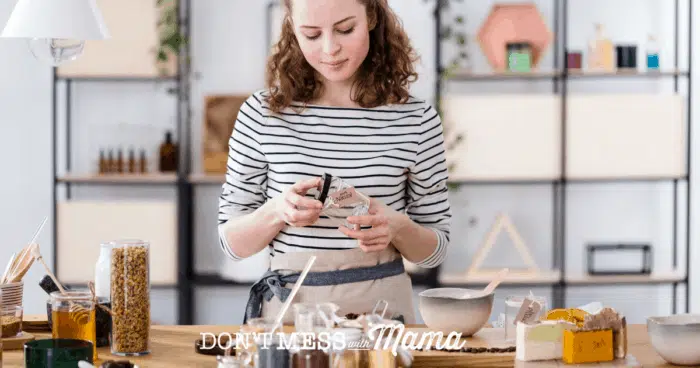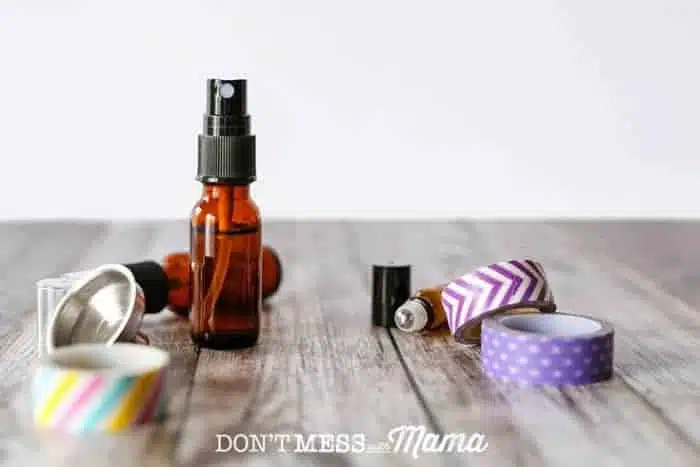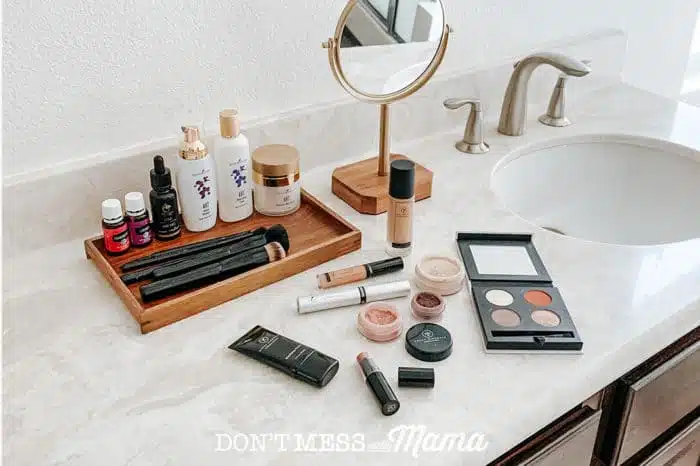7 Products You Should Not DIY – Plus Alternatives
Did you know there are products you should not DIY or make at home as they can cause more harm than good? In the world of natural living, there are many benefits of homemade products – they are cheaper, you’re in control of the ingredients and it can be more sustainable for our planet. However, as this guide reveals, there are instances where homemade is not always best.
This post contains affiliate links. Please read my affiliate disclosure.
As a natural living advocate, I love nothing more than a DIY project to save time, money, and my home from harsh chemicals. However, over the years I have discovered that homemade is not always the safest or most effective option.
This guide is to help you learn from my mistakes and more importantly offer alternatives that are good for your family’s health and your home. That way you can still avoid toxin-filled products from the store, but your DIY projects will not be causing any damage either.
7 Products You Should Not DIY
1. DIY Shampoo
A lot of DIY-based shampoo recipes use castile soap as the base. While castile soap works great for many things, including DIY Hand Soap, it doesn’t do well on the hair, in my opinion.
I find that castile soap is too harsh for the hair and leaves a residue that can leave fine or oily hair looking limp, flat, and greasy. I find dry hair ends up looking like straw and results in more tangles. It can also disrupt the hair’s natural pH balance due to its alkaline content.
If you have hard water, as I do, it can make it even worse as it reacts with the minerals in the water. So, skip the DIY shampoo recipes that use castile soap. From my experience, I’ve yet to find a good DIY shampoo that has both a good lather and doesn’t leave my hair feeling heavy and greasy.
I’m also not a fan of the no-poo method. Gasp. I know, it works for some, but it doesn’t agree with my hair. I’d love to hear from you in the comments if the no-poo method has worked for you.
What to Use Instead: Young Living Volume Shampoo, Young LIving Volume Conditioner, Mirah Hair Oil, Ylang Ylang Essential Oil, Cedarwood Essential Oil
I also like to add essential oils like ylang-ylang and cedarwood to my shampoo and conditioner as both support hair growth by balancing the oil-producing glands in the scalp.
2. DIY Facial Cleanser
It’s no secret traditional facial cleansers are often loaded with toxic ingredients which can strip the skin of natural oils. This has led to a rise in homemade skincare and I do have a DIY Face Wash here on the blog. It is a great introduction to making your own skincare products and I have used that recipe for many years – in a pinch, I’ve gone back to it.
But like my hair, I find that my face does not love castile soap for the long haul. While it has many benefits for oily skin (the soap surrounds excess sebum and helps rinse off oily molecules) it can leave skin dry with excess use.
If you are more prone to dry skin, I’ve done well with the oil cleansing method and as an alternative, I’d suggest using this DIY Facial Oil Moisturizer. Use it as an oil cleaning method base to leave skin cleansed and nourished naturally.
What to Use Instead: ART Gentle Cleanser for normal to aging, Bloom Brightening Cleanser for uneven skin tone, Young Living Charcoal Bar Soap for blemish-prone skin, Orange Blossom Face Wash for oily and teenage skin
3. DIY Facial Toner
I have a great DIY Facial Toner recipe here on the blog made simply with water, apple cider vinegar and essential oils. It’s very budget-friendly and easy to make. However like a lot of homemade skincare it does have a shorter shelf life (about 2 weeks), and some people just don’t love the smell of vinegar.
I understand the appeal of a DIY facial toner as finding a natural toner without an abundance of additives and preservatives can be tough. For years, I thought the drugstore witch hazel I was using was 100% pure but really it had drying ingredients like alcohol.
What to Use Instead: ART Toner
I highly recommend the ART Toner because it’s so gentle on the skin, yet super effective in getting out dirt, grime, and build-up. Even after cleansing, I still find residue on my skin so it’s so satisfying to get it all off and feel my skin glow.
4. DIY Eye Cream
Many homemade eye creams are made with shea butter and coconut oil. While both are natural and contain important vitamins such as vitamin E, they can be too heavy for the face.
I personally find that I break out when I use either shea butter or coconut oil on my face because they are highly comedogenic. This means they clog pores and are known to actually trap dead skin cells underneath which in time causes more harm than good. Plus, it leaves my skin looking greasy, so putting on makeup can be challenging.
What to Use Instead: Wolfberry Eye Cream
The Wolfberry Eye Cream is great for both day (before makeup) or night (right before bed). It’s got antioxidants from wolfberries (also known as goji berries) which help protect and brighten the delicate skin near the eyes naturally. Wolfberries also help maintain moisture as well as promote collagen for a youthful glow.
5. DIY Face Moisturizer
I’ve had the same issue with creamy homemade face moisturizers too. They are often too heavy or make me breakout due to the ingredients, like coconut oil and shea butter.
If I had to go the DIY route, I recommend this DIY Facial Oil Moisturizer. It’s made with rosehip seed oil (or almond oil works well too) which is lightweight and absorbs easily into the skin. Rosehip oil also helps boost collagen and reduce inflammation.
However, sometimes at night I want something a bit heavier to nourish my skin, but without the ingredients that will make me breakout.
What to Use Instead: To achieve the perfect balance of nourishing but not contributing to breakouts these are my recommendations. Sheerlume Face Cream for dry skin and uneven skin tone, Bloom Brightening Face Lotion for uneven skin tone, and ART Light Moisturizer for normal to oily skin.
6. DIY Toothpaste
Many homemade toothpaste recipes have coconut oil and baking soda base. Baking soda is a staple in most kinds of toothpaste as it kills germs and is a safe, gentle abrasive. However, I find that using it directly with just coconut oil can be too abrasive for my teeth and gums.
Using it too often can wear off the top layer of enamel and due being a salt-based product is not the healthiest alternative. Plus, I just never liked the film that coconut oil left on my teeth.
What to Use Instead: Thieves Toothpaste
I am a huge fan of Thieves Toothpaste. My entire family loves it, and it cleans well without the fluoride, harmful peroxides, and other additives in conventional toothpaste. I find it cleans teeth so well by gently removing surface stains and reduces tartar build-up with ease.
7. DIY Laundry Detergent
I used to make DIY Laundry Detergent, but I found over time that there was a residue on my clothes, which can actually happen with traditional detergent too. Yes, I could strip the clothes (where you soak your clothes in a bathtub with borax, washing soda, and laundry detergent), but who’s got time for that?
And yes, a vinegar rinse could help to remove that residue, but if there is an opportunity to cut down the time of my laundry routine then I’m first in line. I needed a natural alternative for my DIY laundry detergent as sometimes buying it ready-made is just easier, right?
What to Use Instead: Thieves Laundry Soap
Therefore I recommend Thieves Laundry Soap as it is a plant-based formula that is gentle and natural as well as super concentrated. One little bottle will do 64 washes. However, as a bonus it can also be diluted to make double that, which is 128 washes.
I add a little of Purification Essential Oil to help with odors, and it cleans without leaving a residue on clothes. As a tip, I use Purification on a couple of wool dryer balls in the dryer to leave my clothes smell so fresh and to soften clothes naturally.
8. DIY Makeup
While DIY makeup isn’t something I’ve done often, I know there are so many tutorials out there. While it seems tempting, I find that it takes so many ingredients to make the DIY makeup that I would never ordinarily use. I’m all about keeping things simple, and not having a closet stockpiled with ingredients I’ll never use again like beetroot powder or kelp powder.
While the lack of preservatives in homemade make up can be seen as a positive, this can also lead to breakouts as bacteria develops quickly. It also means shelf life is limited, so for the amount of effort required to purchase ingredients and create the products, the reward is short lived.
What to Use Instead: Savvy Minerals Makeup
I love this plant-based, mineral makeup line that’s infused with essential oils and natural ingredients like kaolin clay and arrowroot powder. My skin is so sensitive to makeup and will often breakout with traditional cosmetic ingredients.
I am also prone to redness with many makeup brands, but I find Savvy Minerals Makeup to be so nourishing and very flattering. It’s got a buildable color, so it’s easy to go natural, go glam or anything in between. Check out my review on Savvy Minerals Makeup here.
4 Everyday Products You Should DIY
With that being said, there are still everyday products that I make at home and swear by. Not only are these homemade alternatives more cost-effective, but they are easy and simple to make saving you time and your skin from nasty toxins.
1. DIY Perfume
Not only does DIY perfume mean you can create your own custom scent, but you can do it for a fraction of the cost of store-bought brands. Made using just a handful of natural ingredients this is my go-to DIY perfume recipe.
2. DIY Organic Lip Balm
Organic lip balm from the store can be so expensive and at times somes toxins still mange to sneak there way onto the ingredients list. Instead, I swear by this DIY organic lip balm as it works out just $0.24 a tube.
3. DIY Facial Serum
Glowing skin shouldn’t require an expensive price tag or nasty chemicals, which is why I swear by homemade. Not only is this DIY facial serum easy to make but it’s packed with nutrients your skin will love.
4. DIY Natural Breath Spray
While gum or mints can be a natural option to maintain fresh breath, the cost can soon add up. That is why I’m sure you’ll love my DIY Natural Breath Spray as much as I do. Best of all, the flavor can be tailored to your taste and it can also be used as a mouthwash – two products for the price of one.
Hopefully this list of products has made you realize that homemade is not always best. While there are many advantages, from my trial and errors I hope it is evident that there are safer and simpler alternatives out there.
What are your views on DIY? Let me know in the comments below. You can also follow me on Facebook, Instagram and Pinterest.
Want More DIY Recipes?
Check out my book Natural Beauty Made Simple. It comes with 45 homemade skincare recipes with a set of printable labels and gift tags. You can download it instantly to your phone, computer or e-reader, so it’s portable and can go with you anywhere!
- Make your own organic beauty and skin care products for less than $25 a month!
- Learn simple techniques to make your own skincare – without the fuss of complicated recipes or hard-to-find ingredients
- Get tried-and-true recipes that work to nourish the skin and make it look more radiant than ever before
- Create beautiful gifts for friends and family with the printable labels and gift tags I’ve included with this book





At one time I washed my hair with a homemade shampoo made from rye flour, powdered herbs and mustard. I diluted this mixture with water and applied it to my hair for 15 minutes. Hair was clean after washing. But this shampoo had one drawback – the herbs and flour were not completely washed out of the hair. It took a long time to comb them out.
Oh how interesting… I’ve had many fails with DIY shampoo and realized I just prefer buying it.